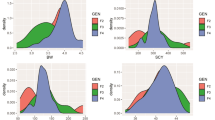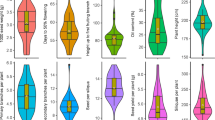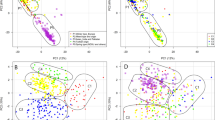Abstract
A single cycle of selection in the F2, F3, F4 and F7 generations using the overall means of the individual hierarchies as their predicted breeding values, has been applied retrospectively to seven metrical traits scored on 784 F7 inbreds extracted from the cross of varieties 2 and 12 of Nicotiana rustica by the method of pedigree inbreeding. The hierarchical structure within 98 F2 groups each of 8 F7 families is further used to determine the distribution and source of the superior inbreds within each hierarchy. While the efficiency of selection improved steadily the more advanced the generations in which it was applied, superior recombinants originated more frequently in the early than in the late generations. The hierarchical method of inbreeding, however, favours the recovery of recombinants from the advanced generations and in the present case the two balance each other exactly. The improvement in response to selection in the advanced generations is completely associated with the relative reductions in error variances and is, therefore, not attributable to any genuine change in the genetic covariances.
The present investigation also confirms that single seed descent is the most cost effective method of producing inbreds from a cross until and unless there are some unforeseen advantages in operating selections in the initial stages of a breeding programme.
Similar content being viewed by others
Article PDF
References
Boughey, H, and Jinks, J L. 1978. Joint selection for both extremes of mean performance and of sensitivity to a macro-environmental variable. III. The determinants of sensitivity. Heredity, 40, 363–369.
Brumpton, R J. Boughey, H, and Jinks, J L. 1977. Joint selection for both extremes of mean performance and of sensitivity to a macro-environmental variable. I. Family selection. Heredity, 30, 219–226.
Jinks, J L, and Pooni, H S. 1981a. Comparative results of selection in early and late stages of an inbreeding programme. Heredity, 46, 1–7.
Jinks, J L, and Pooni, H S. 1981b. Properties of pure breeding lines produced by dihaploidy, single seed descent and pedigree breeding. Heredity, 46, 391–395.
Jinks, J L, and Pooni, H S. 1982. Predicting the properties of pure breeding lines extractable from a cross in the presence of linkage. Heredity, 49, 265–270.
Jinks, J L, and Pooni, H S. 1984. Comparison of inbred lines produced by single seed descent and pedigree inbreeding. Heredity, 53, 299–308.
Jinks, J L. Jayasekara, N E M, and Boughey, H. 1977. Joint selection for both extremes of mean performance and of environmental sensitivity to a macro-environmental variable. II. Single seed descent. Heredity, 39, 345–355.
Pooni, H S. Jinks, J L, and Jayasekara, N E M. 1978. An investigation of gene action and genotype x environment interaction in two crosses of Nicotiana rustica by triple test cross and inbred line analysis. Heredity, 38, 237–251.
Author information
Authors and Affiliations
Rights and permissions
About this article
Cite this article
Pooni, H., Jinks, J. Retrospective selection and sources of superior inbreds amongst pedigree inbred families of Nicotiana rustica. Heredity 54, 255–260 (1985). https://doi.org/10.1038/hdy.1985.34
Received:
Issue date:
DOI: https://doi.org/10.1038/hdy.1985.34
This article is cited by
-
Selfing for the design of genomic selection experiments in biparental plant populations
Theoretical and Applied Genetics (2013)
-
Selection during a selfing programme. I. The effects of a single round of selection
Heredity (1990)



